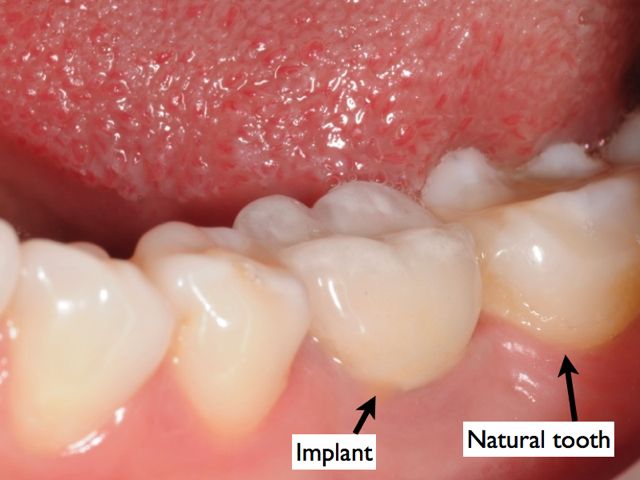 Some patients report trouble with getting food stuck between their teeth next to their dental implants. Not only does this cause annoyance and social embarrassment while trying to remove the food with tongue maneuvers or a toothpick, it can also cause plaque retention leading to gingivitis and gum disease. If you have dental implants and are experiencing food entrapment, there are solutions. However, let’s first take a look at why this happens:
Some patients report trouble with getting food stuck between their teeth next to their dental implants. Not only does this cause annoyance and social embarrassment while trying to remove the food with tongue maneuvers or a toothpick, it can also cause plaque retention leading to gingivitis and gum disease. If you have dental implants and are experiencing food entrapment, there are solutions. However, let’s first take a look at why this happens:
- Implant size too small- The width of the implant is too small in relation to the size of the space of the missing tooth.
- Poorly positioned implant– The implant is not centered in the space and positioned too close to adjacent teeth or tilted.
- Use of stock abutments- These are factory prefabricated components with ‘one-size fits all’ characteristics.
- Poorly fitting crowns- This is the actual tooth part that sits on the implant. Poor fit can happen from low quality fabrication process or inaccurate impression process.
- Crowns with poor shape and open contacts- Crowns with improper contours and contact easily entrap food and make cleaning difficult.
The right solution depends on the cause of the food entrapment. If the implant is too small for the space, your dentist may be able to correct the problem with a customized abutment and a properly formed crown. If this is not effective, the implant may have to be removed and replaced with one that has a correct platform size. Using special instrumentation and techniques, a dental implant can be easily removed and replaced with a new one.
Poorly positioned implants are extremely difficult to restore and they often result in poor cosmetic results and difficult access for cleaning. For implants with a slight degree of misalignment, your dentist may be able to create a customized abutment and crown to correct the problem. However, if the implant is significantly misaligned, removal and replacement with a new implant may be the only viable option.
Use of stock abutments is a very common cause of food entrapment. The abutment is the component that sits on the implant and supports the overlying crown. Abutments are important in developing the transition from the implant to the crown and directly affect the support of the surrounding gum tissue. Some dentists use stock abutments that are factory made and only come in certain sizes, and often fail to develop the proper transition required for aesthetics and gum tissue support. This is why we advocate the use of customized abutments in every patient. Customized abutments are made to fit the space precisely and support the gum tissue properly. They also set the foundation for the overlying crown.
 The crown is the actual tooth that is supported by the abutment, which in-turn is secured to the implant. The crown must fit precisely and sit properly on the abutment. Any gap between the crown and the abutment can result in plaque retention, food entrapment, and gingivitis.
The crown is the actual tooth that is supported by the abutment, which in-turn is secured to the implant. The crown must fit precisely and sit properly on the abutment. Any gap between the crown and the abutment can result in plaque retention, food entrapment, and gingivitis.
The crown must also be made with proper contours and shape, contacting the adjacent teeth just right. Even with properly positioned and sized implants and customized abutments, a poorly shaped crown can result in food entrapment and poor cosmetic results.
How do you avoid such problems to begin with? Here are some key recommendations:
The oral surgeon must select the right implant size that is appropriate for the site of the missing tooth. This is accomplished through proper diagnostic models, cone beam CT scan to assess the availability of bone, and clear communication with the restoring dentist.
The oral surgeon must place the implant in the precise position using a surgical guide. Again, this is achieved through proper diagnostics and collaboration with the restoring dentist before the implant is placed.
The restoring dentist must use customized abutments. This is the only way to create the natural contours for the correct transition from the implant to the crown. While customized abutments cost more, the results are remarkable.
The crown must be fabricated such that it fits precisely over the abutment and has the proper contour and size supporting the surrounding gum tissue. This requires that the restoring dentist provide the laboratory with detailed instructions. Furthermore, the laboratory must use high quality materials and great workmanship provided by skilled technicians and master ceramists.
Replacement of missing teeth with dental implants requires an investment of your time and hard-earned money. The treatment must be carefully planned by your dental team and delivered correctly the first time so you will enjoy headache-free results for years to come.